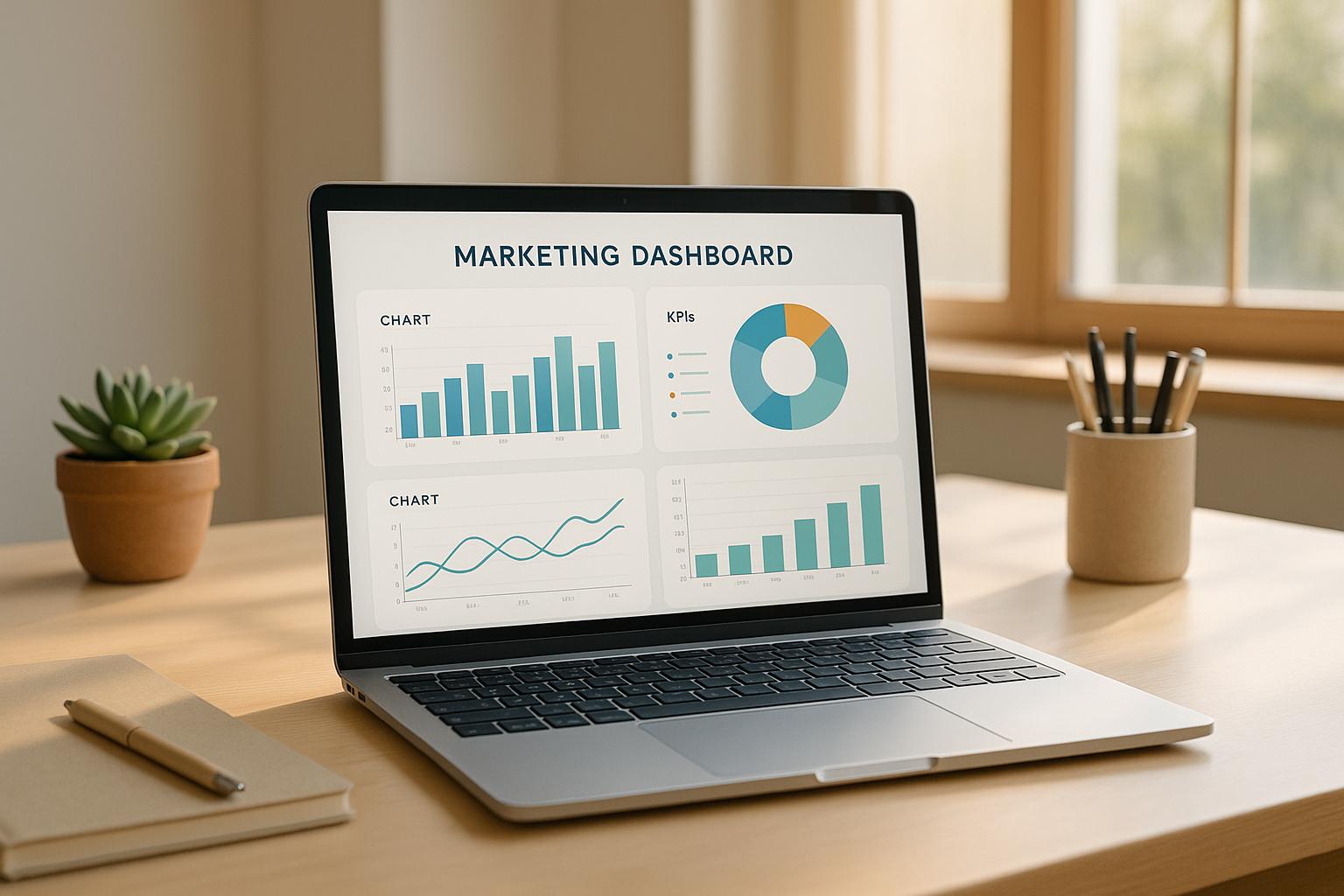Cloud analytics tools help businesses turn massive amounts of data into actionable insights. Here's what you need to know:
- Why they matter: These tools allow real-time data processing, scalability, and improved decision-making.
- Market growth: The cloud analytics market was valued at $33.05 billion in 2023 and is expected to reach $147.19 billion by 2032.
- Top tools: Popular platforms include Power BI, Tableau, Qlik Sense, Domo, and Oracle Analytics Cloud. Each offers unique features like data visualization, AI-powered insights, real-time dashboards, and machine learning capabilities.
Quick Comparison
| Tool | Starting Price (USD) | Key Features | Best For |
|---|---|---|---|
| Power BI | $10/user/month | Seamless Microsoft integration | Microsoft-centric organizations |
| Tableau | $15/user/month | Advanced visualizations | Data visualization experts |
| Qlik Sense | $825/month (20 users) | AI-powered insights | Exploratory data analysis |
| Domo | Custom pricing | Real-time data unification | Real-time business monitoring |
| Oracle Analytics | $16/user/month | Machine learning and enterprise-grade security | Large enterprises |
To choose the right tool, consider factors like data integration, security, scalability, and costs. Start with free trials to test compatibility with your business needs.
How to Liberate Your Enterprise Data for Cloud Analytics, Insights, and Reporting - Webinar
What to Consider When Choosing Cloud Analytics Tools
Picking the right cloud analytics platform is about more than just technology - it's about aligning your choice with your organization's goals and needs. With over 60% of corporate data now stored in the cloud, selecting the right tool can make a huge difference in how effectively your business uncovers insights and drives growth.
To make the best decision, you’ll need to consider your business objectives, data requirements, and operational constraints. Below are some key factors to help you navigate this process and ensure your data strategy is both scalable and secure.
Data Integration and Scalability
A solid cloud analytics platform starts with seamless data integration. The platform should work effortlessly with your existing data systems - databases, cloud storage, third-party apps, and APIs - to eliminate silos and enable a smooth flow of information across your organization.
Your tool should support various data formats and offer real-time ingestion capabilities to ensure your insights are always up-to-date and actionable. Scalability, too, is essential. As your data grows, the platform must be able to scale its storage and processing power automatically, helping you manage fluctuating demands while keeping costs under control.
When evaluating integration capabilities, keep an eye out for these features:
- Support for both batch and real-time data processing
- Pre-built connectors for popular business applications
- APIs for custom integrations
- Data transformation and cleansing tools
- Optimization for handling large datasets
The data integration market is evolving rapidly, reflecting the growing need for tools that can handle these complex demands. Once integration is addressed, it’s time to focus on security and compliance.
Security, Compliance, and Governance
Security and compliance should be at the forefront of your decision-making process. With the global average cost of a data breach reaching $4.45 million in 2023, protecting sensitive data is not optional.
A reliable platform will use strong encryption for data at rest and in transit, along with robust access controls and Identity and Access Management (IAM) features to enforce the principle of least privilege.
Compliance needs vary depending on your industry and location. Ensure the platform meets standards like GDPR, HIPAA, or SOX and includes features like audit trails, data lineage tracking, and compliance reporting to help you demonstrate regulatory adherence.
Data governance features are equally important. These tools ensure data quality and establish clear usage policies across your organization. Look for platforms that provide:
- Data cataloging
- Metadata management
- Automated data quality monitoring
User Access and Cost Management
Ease of use plays a big role in how well a platform is adopted across your organization. The platform should cater to both technical and non-technical users, enabling business teams to create reports and dashboards without relying on IT support.
Think about the variety of roles in your organization. Data scientists may need advanced tools, while executives may prefer simple, actionable dashboards. Make sure the platform supports multiple access levels and is accessible on mobile devices.
Cost is another crucial factor. Many cloud analytics platforms offer flexible pricing models, and understanding these structures can help you avoid surprises. Here’s a comparison of some popular options:
| Platform | Pricing Model | Starting Cost |
|---|---|---|
| Microsoft Power BI | Per user/month | $10 (Pro), $20 (Premium) |
| Tableau | Per user/month | $15 (Viewer), $42 (Explorer), $75 (Creator) |
| Amazon QuickSight | Per user/month | $3 (Reader), $24 (Author) |
| Qlik Cloud Analytics | Monthly subscription | $825 (Standard), $2,500 (Premium) |
| IBM Cognos Analytics | Per user/month | $10.60 (Standard), $42.40 (Premium) |
Don’t just focus on subscription fees. Factor in implementation costs, training, and potential charges for adding users or features. Some platforms may also limit data volumes or processing power, which could lead to unexpected expenses as your usage grows.
Finally, check the vendor’s documentation, training materials, and customer support. Community forums and feedback from reference customers can also provide valuable insights into the platform’s strengths and potential drawbacks.
Before committing, take advantage of free trials or demos to see if the platform meets your specific needs. This hands-on experience can be invaluable in making an informed decision.
Best Cloud Analytics Tools for Enterprises
Let’s dive into some of the top cloud analytics tools designed to meet enterprise needs. Each platform offers distinct capabilities tailored to different organizational priorities.
Tableau
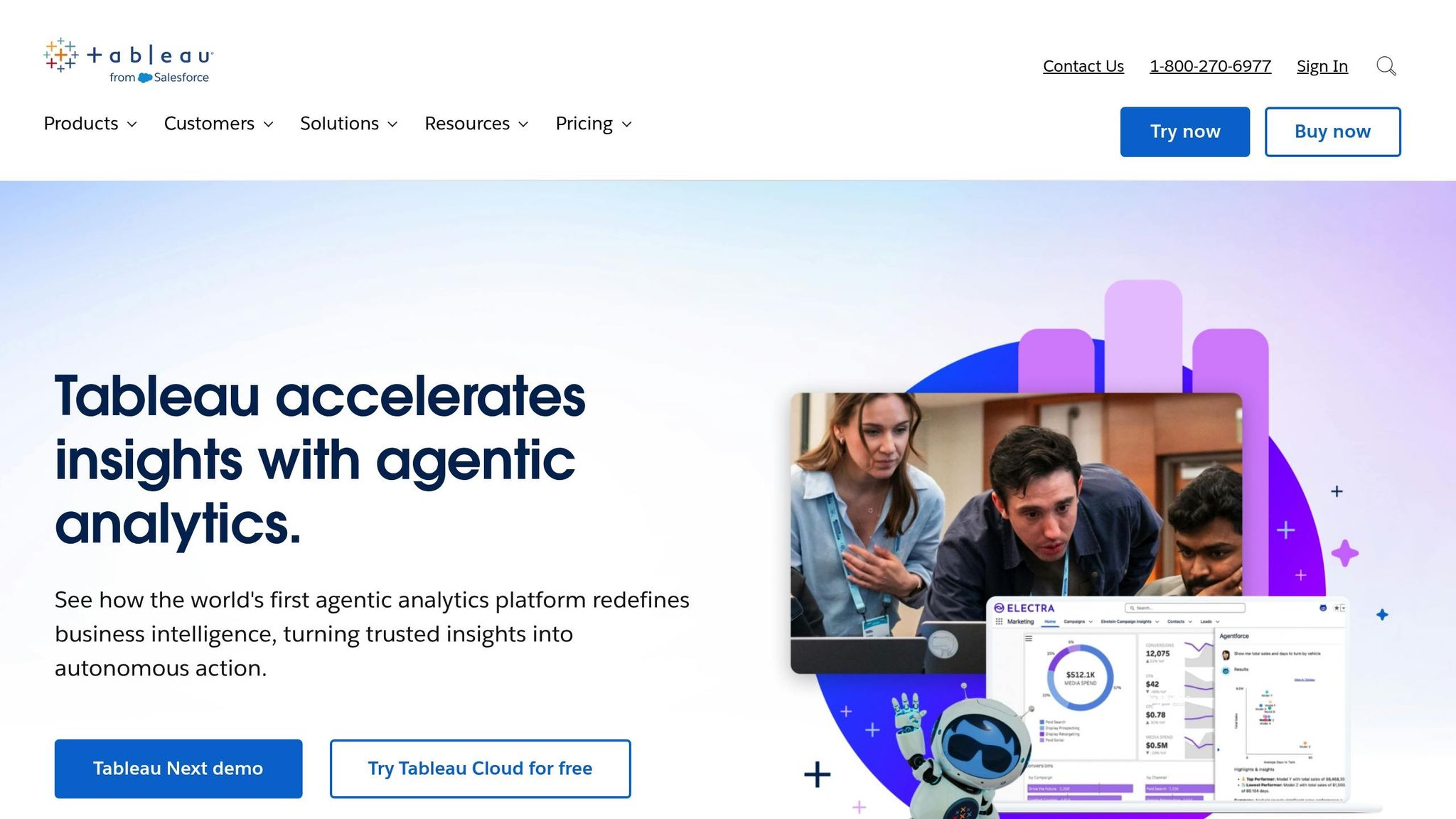
Tableau stands out for its ability to create dynamic data visualizations and share dashboards effortlessly. Designed for both technical and non-technical users, it allows for interactive visualization without requiring advanced coding skills. The platform handles massive datasets efficiently and includes customizable dashboards alongside robust data governance features, ensuring enterprise-grade security and compliance. Its compatibility with both cloud and on-premises data sources makes it versatile.
Pricing is tiered: Creator costs $75 per user per month, Explorer is $42 per user per month, and Viewer is $15 per user per month (all billed annually). Tableau holds a user rating of 4.3 out of 5. For those seeking AI-driven insights, Qlik Sense provides an intriguing alternative.
Qlik Sense (Qlik Cloud Analytics)
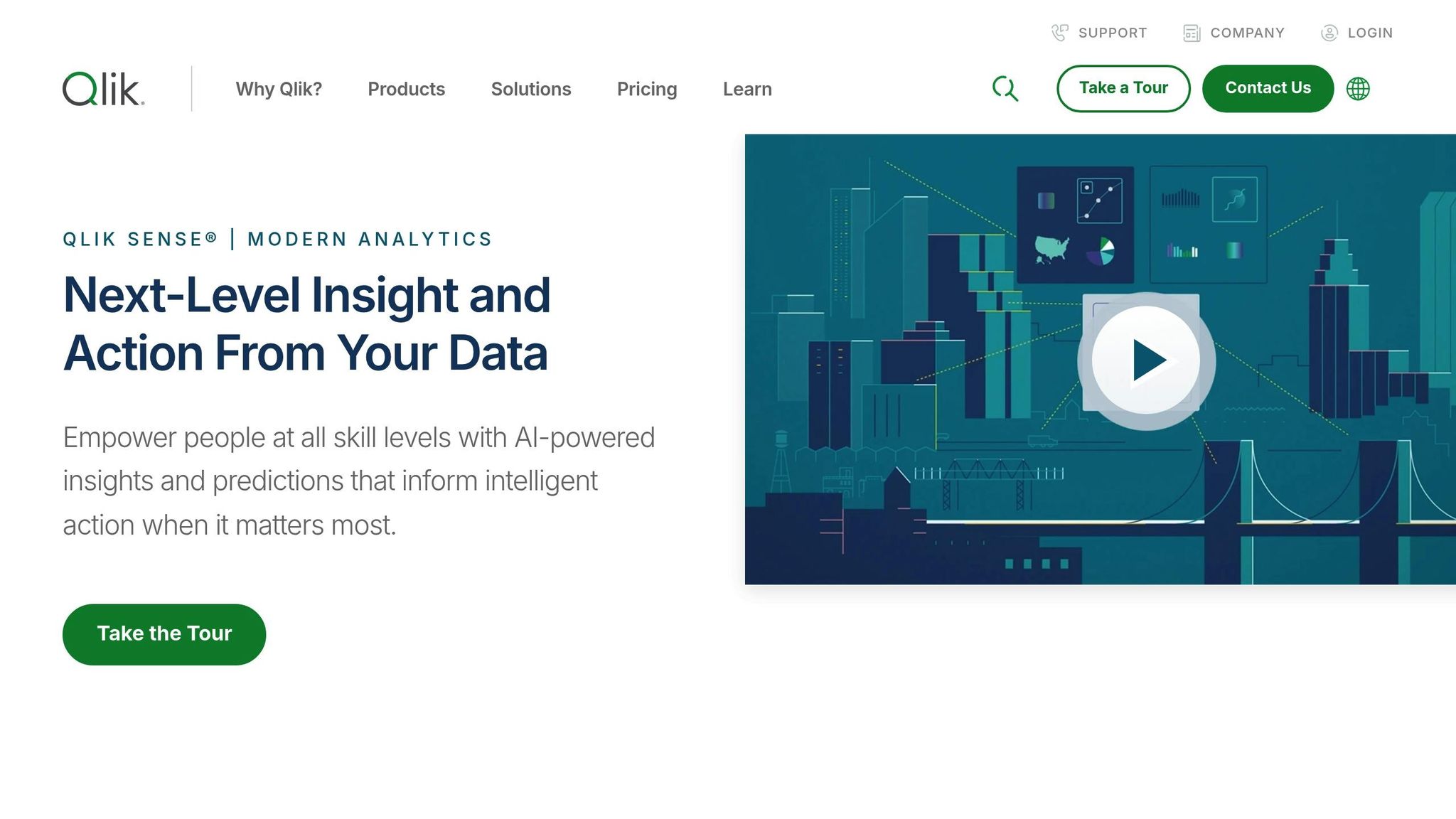
Qlik Sense offers a flexible, AI-powered analytics platform that helps organizations uncover patterns and insights hidden in their data. Its associative analytics engine allows users to explore data relationships interactively, while features like natural language processing and automation enhance usability.
"Intuit relies on Qlik Sense to power a company-wide portal that eliminates reporting inconsistencies caused by data silos. Over a third of their workforce uses the portal for real-time analytics, achieving a 10X adoption increase in just two years."
Pricing starts at $825 per month for the Standard plan, which includes 25 GB of data annually and supports 20 full users. The Premium plan begins at $2,500 per month, offering 50 GB per year and accommodating up to 100,000 basic users.
Domo
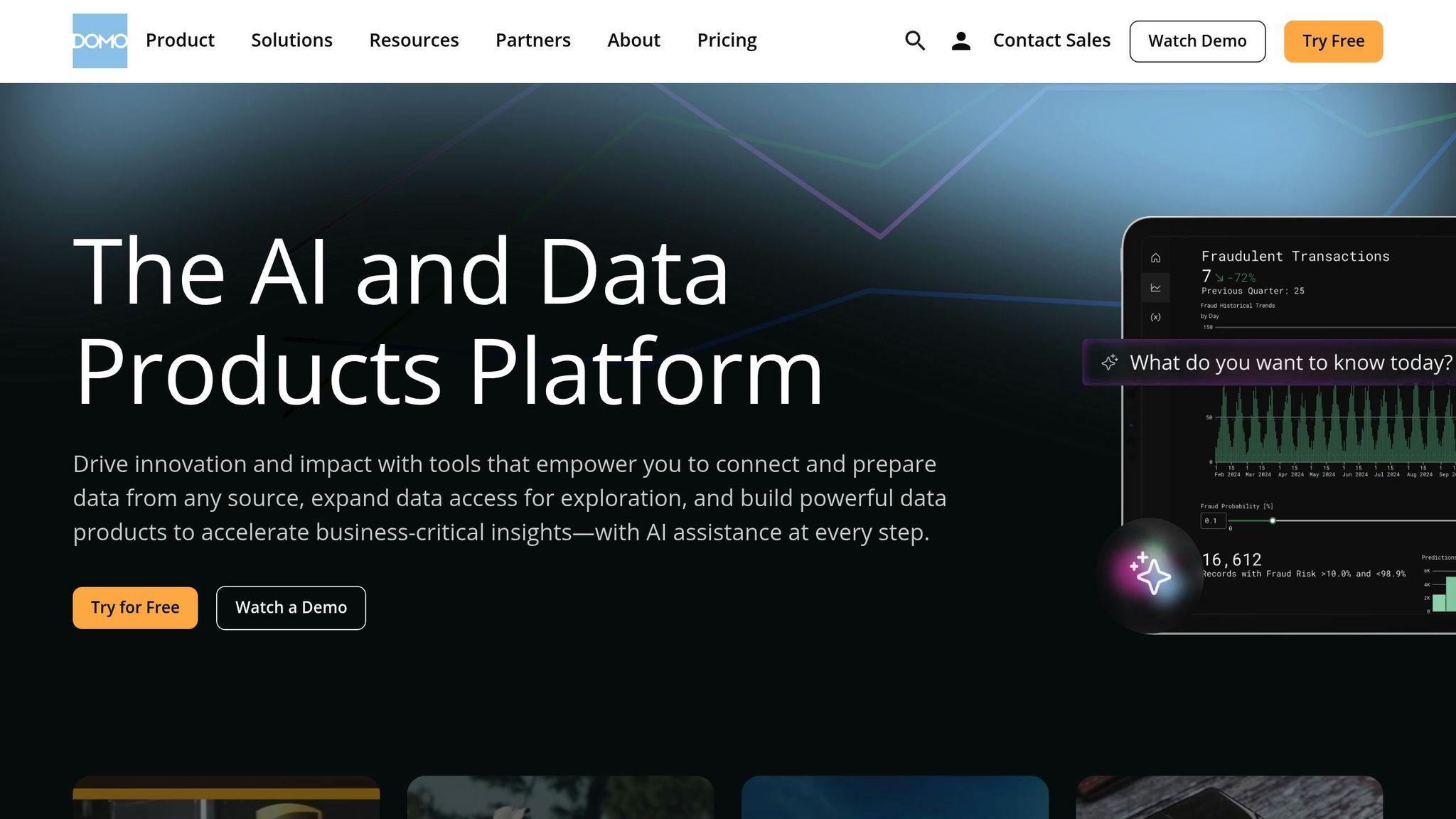
Domo simplifies data management by combining data warehousing, ETL (Extract, Transform, Load), and analytics into one platform. It offers self-service ETL tools, analytics, and data science features to provide real-time business insights.
"Emerson uses Domo dashboards to monitor equipment performance, translating complex engineering metrics into easy-to-understand client information, ensuring real-time visibility into performance."
With a user rating of 4.4 out of 5, Domo is praised for its ability to unify data in real time and its user-friendly design.
Power BI
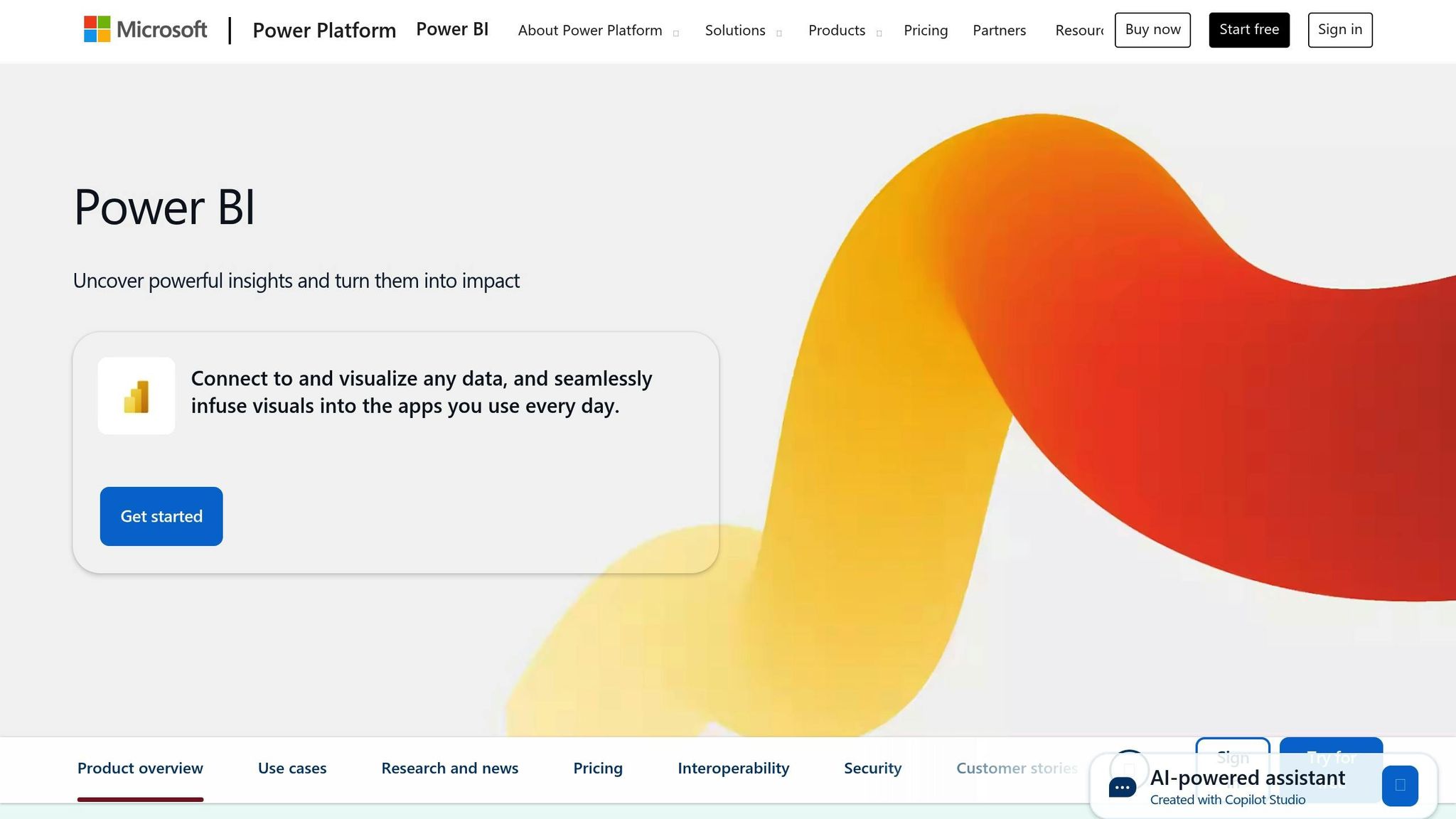
Microsoft Power BI is a go-to choice for organizations already invested in Microsoft products. It integrates seamlessly with the Microsoft ecosystem, offering powerful visualization tools and embedded analytics. Power BI balances advanced governance and administration capabilities with an intuitive interface that’s accessible for business analysts.
The platform has a user rating of 4.5 out of 5. At $14 per user per month (billed annually) for Power BI Pro, it’s one of the most budget-friendly enterprise solutions. Many organizations also benefit from its inclusion in Microsoft enterprise licenses.
Oracle Analytics Cloud
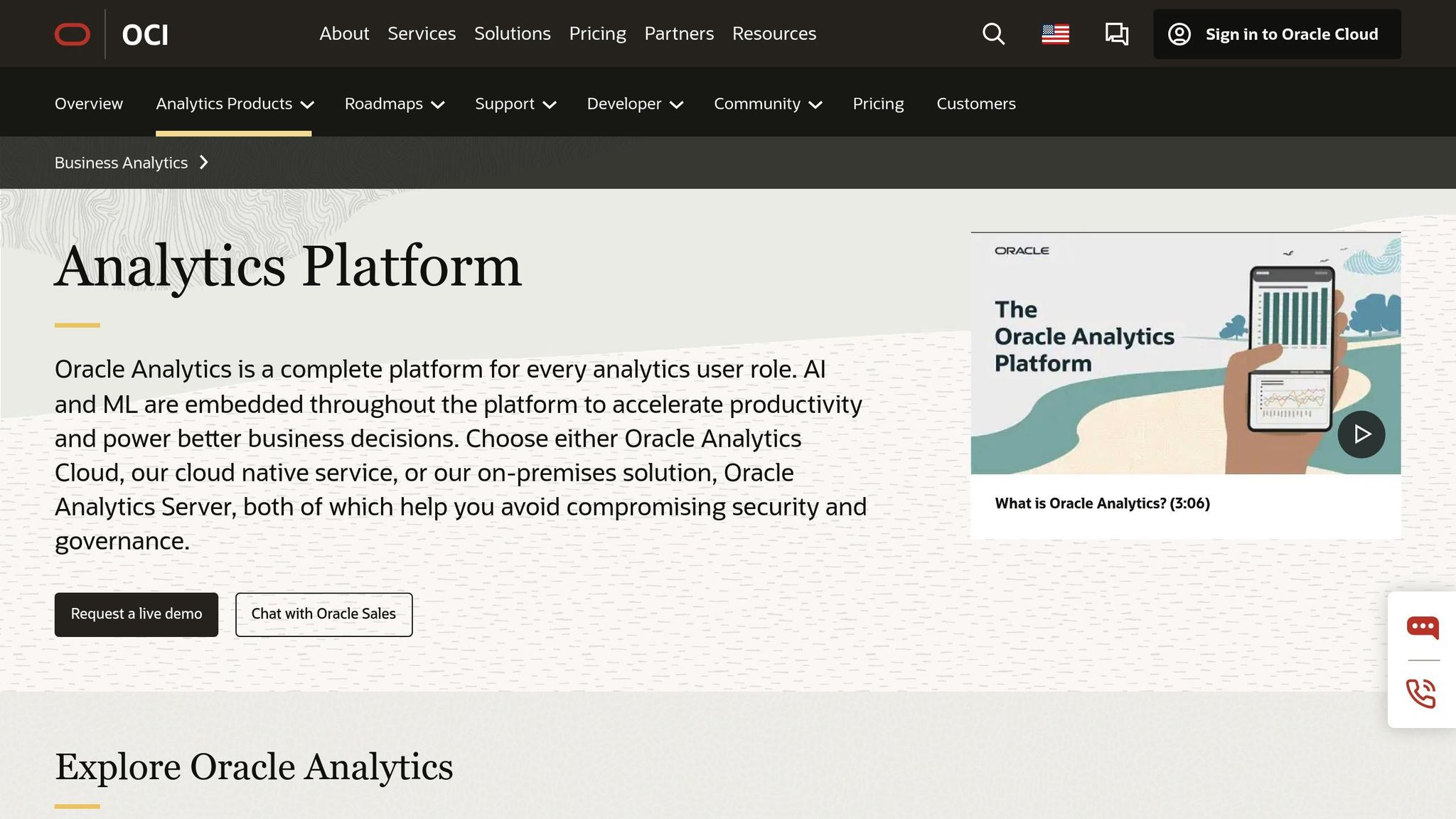
Oracle Analytics Cloud brings machine learning into the mix, offering a holistic view of business performance. It’s especially suited for large enterprises looking to modernize their analytics infrastructure. The platform integrates data from various departments, including sales, marketing, finance, and supply chain, while providing predictive analytics and enterprise-grade security.
Pricing options include a Professional edition at $16 per user per month and an Enterprise edition at $80 per user per month. With a user rating of 4.2 out of 5, it’s often highlighted for its ability to manage complex, large-scale data architectures.
sbb-itb-5174ba0
Cloud Analytics Tools Comparison
Comparison Table
Here’s a quick overview of some of the leading cloud analytics tools, highlighting their pricing, user ratings, and standout features. This table is designed to help you compare their capabilities and determine which tool best fits your needs:
| Tool | Monthly Pricing (USD) | User Rating | Key Strengths | Data Integration | Analytics Engine | Best For |
|---|---|---|---|---|---|---|
| Power BI | $10/user (Pro) | 4.5/5 | Seamless Microsoft integration, affordable | Flat files, SQL databases, Azure cloud, online services | Proprietary analytics engine | Microsoft-focused organizations |
| Tableau | $75/user (Creator) | 4.3/5 | Advanced visualizations, drag-and-drop interface | Excel, CSV, Oracle, DB2, SQL Server, Google BigQuery, Windows Azure | VizQL interface | Data visualization experts |
| Qlik Sense | $825/month (Standard, 20 users) | 4.6/5 | AI-powered insights, associative data model | Amazon Redshift, Apache Drill, Spark, Hive, Azure SQL, Google BigQuery | AI-driven analytics | Exploratory analysis |
| Domo | Custom pricing | 4.4/5 | Real-time insights, extensive connector library | ODBC, SAP, XML, JIRA, QuickBooks, and 1,000+ cloud connectors | Built-in data science tools | Real-time business monitoring |
| Oracle Analytics Cloud | Custom pricing | 4.2/5 | Enterprise-grade machine learning, robust analytics | Comprehensive data ingestion and modeling | Machine learning integration | Large enterprises |
According to SelectHub analyst scores, Power BI leads with 89%, followed by Tableau (88%), Domo (87%), Qlik Sense (85%), and Oracle Analytics Cloud (83%).
Main Differences Between Tools
Each tool offers distinct advantages, and the right choice often depends on your organization’s priorities and existing tech stack. Here’s a closer look at their differentiators:
- Power BI: Ideal for businesses already using Microsoft products, Power BI integrates effortlessly with Azure and offers a budget-friendly entry point at $10 per user/month. Its 4.5/5 user rating reflects its popularity among Microsoft-centric enterprises.
- Tableau: Known for its cutting-edge visualizations and user-friendly drag-and-drop interface, Tableau is a favorite for data visualization specialists. However, its ETL (extract, transform, load) capabilities require an additional Tableau Prep subscription.
- Qlik Sense: This platform excels in exploratory data analysis, thanks to its associative data model, which automatically indexes relationships between data points. This feature minimizes setup time and simplifies complex analysis.
- Domo: Domo’s strength lies in real-time data processing and its extensive library of over 1,000 prebuilt connectors. For example, in November 2024, Domo helped a client save hundreds of hours by automating predictions for game viewership through its dataflow engine.
- Oracle Analytics Cloud: Built for large enterprises, Oracle’s platform combines data ingestion, modeling, visualization, and collaboration features. It includes robust security and machine learning capabilities, though its ease of use is rated slightly lower.
Pricing and Cost Considerations
Pricing varies significantly across these platforms. Power BI starts at $10/user/month, making it an affordable option for smaller teams, while Qlik Sense costs $825/month for 20 users and 25 GB of storage. Keep in mind that the total cost of ownership extends beyond subscription fees - it also includes training, implementation, and ongoing maintenance.
"Modern self-service BI platforms provide user-friendly interfaces, often with low-code drag-and-drop functionality. Importantly, though, modern platforms also feature data governance capabilities, security and role management functions, native integrations and data connectors, large libraries of data visualization types, and painless management of development-testing-production phases."
- ETR Observatory
Common Challenges and Solutions in Cloud Analytics
Cloud analytics offers businesses incredible opportunities to gain insights, but it’s not without its hurdles. To truly benefit, organizations need to address these challenges head-on with practical strategies.
Data Security and Compliance
The Challenge: Security remains a top concern for enterprises moving analytics to the cloud. According to a 2022 Cloud Security Alliance study, 67% of organizations store sensitive data in public clouds, yet 44% admit they lack confidence in protecting it. This gap in confidence poses significant risks. For instance, Sophos’ 2025 State of Ransomware Report found that recovery costs skyrocketed to $2.73 million in 2025 from $1.82 million in 2023.
Misconfigurations are a major culprit. Verizon reports that 13% of breaches stem from cloud misconfigurations. A striking example is Toyota’s 2023 incident, where a simple misconfiguration exposed data from 260,000 customers for over eight years, including sensitive in-vehicle device IDs and map updates.
The Solutions: Leveraging AI-powered cloud security tools can help detect misconfigurations in real time and automate responses. As Oliver Scherer, CISO of MediaMarktSaturn Retail Group, puts it:
"AI offers huge opportunities for cybersecurity. This is because you move from detection, manual reaction and remediation towards an automated remediation, which organizations would like to achieve in the next three or five years."
Additionally, establishing clear data governance policies is critical. These policies should define roles, access controls, data classification, and retention protocols. To maintain compliance, consider deploying a cloud access security broker (CASB) to automate monitoring. Cisco’s 2023 report highlights that 30% of professionals rank compliance as a top priority for maintaining customer trust. Regular audits and employee training further strengthen your security posture.
Once security is addressed, enterprises often face the challenge of integrating cloud analytics tools with existing systems.
Integration and Performance at Scale
The Challenge: Integrating cloud analytics tools with legacy enterprise systems can be tricky. The ISC2 2025 report notes that 52% of IT professionals encounter compatibility issues when implementing new cloud security tools. Legacy systems often lack visibility and interoperability, making the transition to cloud platforms even more complex.
The Solutions: Start by conducting a comprehensive infrastructure assessment before migration. This evaluation identifies the strengths and weaknesses of your current systems, helping you choose platforms that support standard data formats and protocols for seamless integration.
Developing a well-defined cloud integration strategy is equally important. This strategy should include planning, testing, performance monitoring, and scaling considerations. Aligning cloud migration with specific business goals ensures that the process delivers measurable results, rather than becoming a purely technical exercise.
A great example comes from a US-based food company that partnered with EIRE Systems to revamp its IT infrastructure. By adopting a hybrid cloud model, the company achieved significant cost savings, improved productivity, and reduced risks.
To minimize security risks during integration, use secure APIs and work with reputable cloud providers. Prioritize projects that align with business objectives, and focus on early successes to build momentum.
After overcoming integration hurdles, managing costs and ensuring user adoption become the next critical areas to address.
Cost Management and User Adoption
The Challenge: Cloud analytics can be expensive if not carefully managed. Studies show that companies waste up to 32% of their cloud budgets, and only 3 out of 10 organizations clearly understand their cloud spending.
User adoption is another challenge. While technical teams may embrace new tools, business users often resist change, especially if the tools are complex or training is insufficient.
The Solutions: To manage costs, regularly audit cloud spending to identify inefficiencies and eliminate waste. Pay close attention to contract details, particularly egress fees and storage pricing, which can lead to unexpected expenses. Start with high-impact projects that align with business goals, and demonstrate value quickly to justify further investment.
Creating a Cloud Center of Excellence can help establish consistent standards and best practices across the organization. This centralized approach not only controls costs but also ensures smoother implementation.
For user adoption, focus on designing intuitive, purpose-driven visualizations that address specific business challenges. Provide ongoing training to help employees understand not just how to use the tools, but why they are important for their roles. Adoption improves when users see immediate value in their daily tasks, rather than being forced to adapt to overly complex systems.
As Peter Drucker famously said:
"The best way to predict the future is to create it."
This sentiment perfectly captures the spirit of cloud analytics - success depends on proactively addressing these challenges rather than waiting for them to resolve on their own.
Conclusion
Choosing the right cloud analytics tool means finding one that matches your business goals. Each platform offers distinct strengths: Tableau stands out with its impressive visualizations, Power BI works seamlessly within the Microsoft ecosystem, Qlik Sense provides flexible data exploration, Domo combines multiple functions in one place, and Oracle Analytics Cloud brings enterprise-level AI capabilities. These differences are essential to consider in a market that’s evolving at lightning speed.
The rapid growth of the analytics market and the steep costs of poor data quality make it clear - delaying your analytics transformation isn’t an option.
As previously discussed, the integration of real-time analytics and AI is becoming increasingly important. Ash Sharma, AI Product Leader at Amazon, puts it well:
"AI can help make sense of the large volume of analytics that are produced and never get in front of stakeholders. Natural language and conversational interfaces are a great value add for non-technical audiences to query an AI system - 'which customer segment had the largest repeat usage last week?' - to quickly get insights and disseminate them throughout the organization".
When evaluating tools, focus on scalability to handle growing data, integration with your current systems, security to protect sensitive information, and pricing that fits your budget. Just as important is user adoption - even the most advanced tool is useless if your team doesn’t embrace it. These priorities reflect the challenges and solutions discussed earlier and will guide you to make informed decisions.
Take advantage of free trials to test platforms with your real data before committing. Setting SMART goals (specific, measurable, achievable, relevant, and time-bound) can help steer your selection process effectively. As the SEI Team wisely advises: "The best analytics strategies start with sharp questions, not shiny tools".
For further assistance in narrowing down your options, check out the Marketing Analytics Tools Directory to compare solutions tailored to your needs and budget.
FAQs
What should I look for when selecting a cloud analytics tool for my business?
When you're choosing a cloud analytics tool, it's important to weigh a few critical factors to make sure it fits your business needs:
- Business Goals: Look for a tool that matches what you're aiming to achieve - whether that's monitoring performance, understanding your audience better, or improving how your operations run.
- Budget: Check the total costs, including subscription fees and any potential hidden charges, to ensure it aligns with your financial plan.
- User-Friendliness: Go for a platform that's easy to navigate, making it accessible for both tech-savvy users and those less familiar with analytics tools.
- Compatibility: Make sure the tool integrates smoothly with your current systems and data sources to avoid unnecessary headaches.
- Room to Grow: Choose a solution that can scale with your business as it expands or evolves over time.
By keeping these points in mind, you'll be better equipped to select a cloud analytics tool that not only meets your current demands but also helps uncover actionable insights to drive your business forward.
How do cloud analytics tools protect data and ensure compliance with industry regulations?
Cloud analytics tools play a crucial role in protecting data and ensuring compliance by using strong security protocols and following specific industry regulations. They rely on encryption to secure data both during storage and while it’s being transmitted, effectively blocking unauthorized access to sensitive information.
These tools are also designed to meet major regulatory standards like GDPR, HIPAA, and PCI DSS. These frameworks set strict guidelines for how data is stored, handled, and protected. By adhering to these rules, businesses can reduce risks, avoid costly legal issues, and build trust with their customers.
On top of that, many platforms allow for custom security settings and access controls. This flexibility lets companies adapt their data protection strategies to fit their specific needs while keeping up with changing regulatory requirements.
What are the costs of using a cloud analytics platform, and how can businesses control them effectively?
The cost of using a cloud analytics platform can vary significantly, depending on factors like how much data you store, the computing power you need, and the volume of data transfers. Many platforms operate on a pay-as-you-go pricing model, which sounds flexible but can lead to unexpected charges if your resource usage suddenly spikes. This makes it essential for businesses to keep a close eye on their cloud usage and identify inefficiencies, such as idle resources or overprovisioned services, that could be driving up costs unnecessarily.
To keep spending under control, it’s a good idea to set clear budgets and use cloud cost management tools to track your expenses in real time. Implementing tagging strategies can also help you monitor costs by project or department, making it easier to see where your money is going. These steps ensure your cloud investments stay aligned with your business objectives while helping you get the most value for your money.

